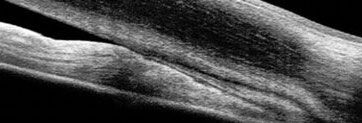 |
|
Recent study confirms a higher risk of angle closure among asymptomatic Chinese adults. Photo: Michael Cymbor, OD. Click image to enlarge. |
Individuals with a high risk of angle closure don’t always seek eyecare services due to the absence of disease awareness and lack of convenient and low-cost access to ocular health care. A study recently described the efficacy of a health examination center-based screening model designed to detect eyes at high risk of angle closure using anterior segment OCT (AS-OCT).
For two months, 991 individuals aged 40 and older were followed as they underwent routine physical examinations. Presenting visual acuity, intraocular pressure, non-mydriatic fundus photography and AS-OCT were performed. Eyes with a high risk of angle closure were defined as having a trabecular iris angle less than 12° in more than three quadrants.
A high risk of angle closure was diagnosed in 78 eyes and was most prevalent among asymptomatic Chinese adults. The prevalence was higher among women (11.2%) than men (5.5%). The mixed-mechanism iris configuration was most common among eyes with high-risk angle closure (47.4%).
The authors noted that the health examination center screening model provides an opportunity to detect these asymptomatic individuals and prevent severe visual impairment through intense follow-up and prophylactic management when necessary. “AS-OCT is quick and noninvasive and, combined with a semi-quantitative assessment as described here, can be readily performed by non-specialists after modest training or by artificial intelligence software in the near future,” the paper explained.
They also noted the importance of the value of screening for narrow angles, citing a previous study that showed the five-year progression from primary angle-closure suspect to patient, about 6.1% in Chinese populations.
“A strict, objective and reasonable criterion for defining high-risk angles is of special importance to avoid an undue burden on the healthcare system, particularly in countries like China with comparatively scarce resources,” the authors noted in their paper.
“Since health examinations at most centers are repeated annually, our health examination center-based AS-OCT screening model provides ample opportunity for early detection, patient education and continuous monitoring of eyes with high-risk angle closure,” the authors concluded. “It may ultimately improve the access to appropriate interventions among this population and help to reduce visual impairment associated with angle-closure glaucoma.”
Lin S, Hu Y, Ye C, et al. Detecting eyes with high risk of angle closure among apparently normal eyes by anterior segment OCT: a health examination center-based model. BMC Ophthalmol. December 28, 2022. [Epub ahead of print]. |

